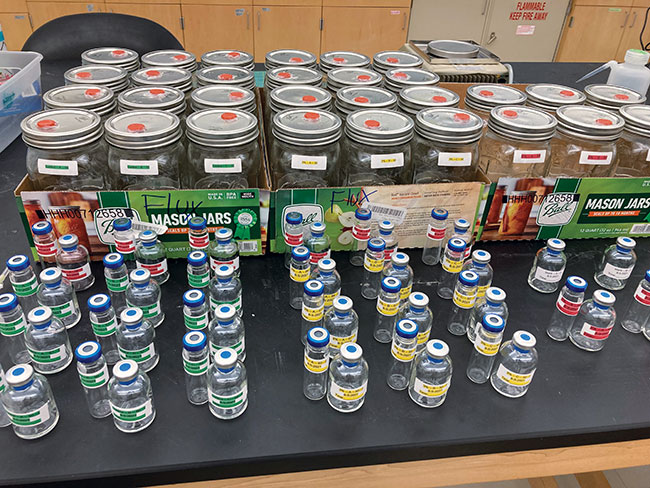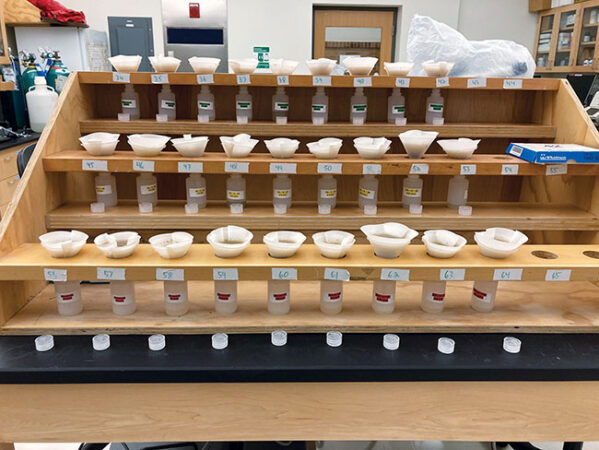
Features
Environment Protection
Protection
From surf to turf
Adding seaweed to a cow’s diet reduces methane production – but what about the manure quality?
April 9, 2024 by Jack Kazmierski
 Closed jars to sample gas emissions at the Woodwell Climate Research Center.
All images courtesy of Kyle Arndt.
Closed jars to sample gas emissions at the Woodwell Climate Research Center.
All images courtesy of Kyle Arndt. Recently published research has analyzed the benefits of adding seaweed to feed consumed by dairy cows. The study looked at the impact seaweed supplementation has on enteric methane emissions (methane produced within the cow’s intestines), as well as whether the addition of seaweed to feed affects the quality of the manure produced by these cows, and in turn, the impact that could have on crops. Their initial findings are very encouraging.
Research was conducted during 2021 and 2022, with final results published in late 2023. “Seaweed feeding trials have been going on in the livestock industry for a while now, feeding primarily red algae species of seaweed to ruminant animals in order to reduce their enteric methane emissions,” explains Dr. Kyle Arndt, research scientist at the Woodwell Climate Research Center. “So as we deal with the climate crisis, it’s been discovered that certain species of seaweed can reduce and inhibit methane emissions from these animals.”
What sets this apart from many other seaweed studies, Arndt says, is that he and his colleagues set out to look at the full lifecycle effects, to see how manure produced by seaweed-fed cows would affect soil samples.
“We took soils from different pastures, mixed it with the manures that came from these animals and wanted to see how the nutrient cycling, greenhouse gas emissions, decomposition, and all the biogeochemistry downstream interacted,” he adds.
28-day trial
Cows were fed a diet with seaweed for a period of two months. Thereafter, researchers conducted a 28‐day soil and manure incubation trial, utilizing manures collected from these dairy cows. In addition to a control group, which consumed a diet with no seaweed supplementation, the study included two additional groups: cows that received a three percent and a six percent (by dry‐weight) seaweed supplement to their feed. A larger percentage of seaweed was not attempted, simply because of the dietary needs of these animals.
Dr. Nichole Price, senior research scientist and director at the Bigelow Center for Seafood Solutions explains. “The upper limit of how much seaweed you include in a cow’s diet is driven by the nutrition demands of the animal,” she explains. “So you can’t replace too much of [the regular feed]. The other issue was iodine, and six percent was the most we could include in the diet without running into excess of iodine issues.”
Three soil moisture treatments were tested. The first had a field moisture capacity of 67 percent gravimetric water content (GWC), the second was a bit drier (50 percent GWC), and the third was more saturated (84 percent GWC).
Going into the study, the research team wasn’t expecting to see a big impact on soil samples. “I didn’t think we would see much, just because the dry weight inclusion of the seaweed – three percent and six percent – is so low. It’s a small percentage of the feed,” explains Arndt. “So given that’s it’s such a small part of their feed to begin with, I assumed we wouldn’t really see many downstream results.”
That said, “not seeing many results” is actually a good thing, when it comes to this study. “If you don’t see any negative consequences of adding seaweed to the feed, and you still see a reduction in enteric methane emissions, then it’s still a successful strategy,” adds Arndt.
Reduction in methane
As far as methane emissions go, the results of this research proved to be very impressive. “I think some perspective on the amount of methane emissions reduction is important to have,” says Price. “Depending on the seaweed species and the bioactive compounds, you can have an 80 to 90 percent reduction in enteric methane emissions.”
This is great news, if you look at this study through a greenhouse gas emissions lens. However, if you’re looking at this study through a “quality of manure” lens, you might be asking a number of questions. “What we’re seeing from the dairy industry is a concern that there’ll be some residues of that bioactive compound coming through in the manure,” explains Price. “That can be good if you’re worried about methane emissions from a lagoon, I suppose, but you’d be concerned about how it interacts with soils and crops, or how it might impact the performance of anaerobic digester systems.”
These concerns, Price adds, were the reason for this new research. “There are a lot of folks in the milk production industry who are paying attention to these sustainability approaches,” she adds, “and they certainly want to avoid any unintended consequences by applying something that’s so effective in ruminant animals.”
Impact on soil
Arndt says that researchers came up with a few unexpected findings. “Surprisingly, we found a reduction in CO2 emissions from the soil/manure mixtures,” he says.

A tulip corer, which was used to collect the samples as part of the research project.
In brief, researchers published the following results: “We found that manure from seaweed‐fed cows reduced emissions of carbon dioxide and had similar emissions of methane and nitrous oxide [when compared with] the control [group]. Higher moisture levels increased CH4 emissions and nitrous oxide emissions with CH4 emissions trending higher in seaweed supplements. Inorganic nitrogen turnover varied more based on moisture levels than seaweed supplements, as did the magnitude of methane and nitrous oxide emissions. Total carbon and nitrogen mostly decreased except in the three percent seaweed supplementation, which increased carbon and nitrogen, with a drop in [carbon and nitrogen] in the 50 percent GWC group.”
“The differences we saw with the various moisture levels was not surprising,” Arndt adds, “and that’s based on the behaviour of the different bacteria on microbial life that make those different gasses. So the saturated soil had higher methane emissions because that’s an anaerobic process, while the [drier (50 percent GWC)] soil had the highest nitrous oxide emissions.”
As far as nutrients go, Arndt says there was no negative impact. “It didn’t harm the quality of the manure to act as a fertilizer. Based on our findings, the manure is similar in quality… Seaweed supplements may partially reduce climate impacts of manures from cows fed seaweed supplements, or at least not cause harm or impact manure quality.”
“No harm is good news,” Price adds. “The manure will do no harm, and it may do some good. How much more good, we don’t know yet.”
Next steps
Arndt says that more research is needed. Although researchers don’t know how crop growth would be impacted, if at all, Arndt says the nutrient profiles of the manure from the seaweed-fed cows was unchanged. “It gives us hope that this manure would behave like manure from cows that were not fed this diet.”
Inorganic nitrogen did drop a bit, when compared with manure from cows that were fed a regular diet. “But there was no difference [when compared with] the manure from cows who had the three percent seaweed diet,” he explains. “However, once the manure was mixed with the pastures, there was no difference in the cycling and the total nutrient use.”

KCI extractions for inorganic nitrogen.
Other seaweed species
In addition to studies involving actual crops and plants, Price says more research has to be done with other species of seaweed. “This was a trial with one species of seaweed, prepared one way, with two inclusion levels,” she says. “There are hundreds of species of seaweed that could be used, and then thousands of species of micro algae that could be used. So we are really only scratching the surface of what’s possible.”
In addition, Price explains how other variables can impact manure quality. “Depending on how any of those strains or species are reared, or grown, and then processed, you can alter their biogeochemical profiles and the amount of bioactive compounds,” she explains. “So I would say this is the start to a long series of experiments that we’re planning in order to figure out where you can optimize performance and reduce any sort of unintended consequences.”
Price says plans are in the works for another study, which will begin in March 2024, looking at another species of seaweed.
As stated before, researchers are really only scratching the surface of all the possibilities at this point, and we’re still far from the point where we know which seaweed options are best, or how to make seaweed supplementation easy and financially viable for dairy farmers.
“Right now, it’s easy for a farmer to buy kelp meal, but that won’t reduce enteric methane emissions,” explains Price.
“It isn’t easy yet for a farmer to buy seaweed to reduce enteric methane emissions, but that’s the overarching goal of our research program. •